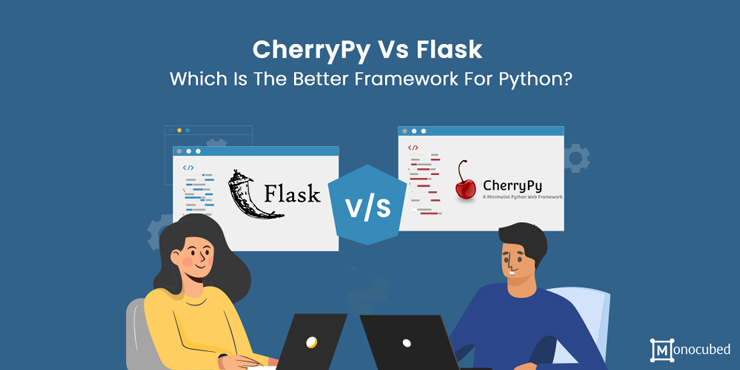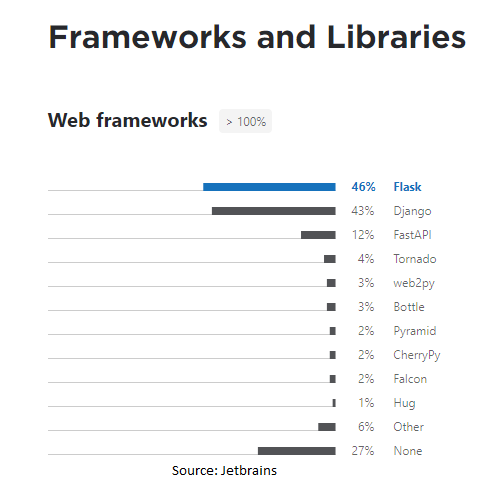When it comes to backend development, Python is one of the best programming languages to use. Many Python web frameworks are available in the market, ranging from robust, batteries-included frameworks, such as Django or Web2py, or lightweight micro-frameworks, such as Flask, CherryPy, and Pyramid.
As a Python development company, we have hands-on experience using these frameworks. We bring you a comparison of two such microframeworks. Flask is the most popular Python web framework after Django, while CherryPy is one of the oldest web application frameworks. This CherryPy vs Flask battle will assist you in deciding which framework is suitable for your product.
Table of Content
CherryPy VS Flask – A Comparison Table
We have curated a comparison table for you to quickly peruse through before we look at these frameworks and their individual features in detail.
| Attributes | CherryPy | Flask |
|---|---|---|
| Definition | CherryPy is a minimalistic framework for Python development | Flask is a Python-based micro web framework |
| Object Oriented | CherryPy is object-oriented | Flask is not object-oriented |
| Release date | Released in 2002 | Released in 2010 |
| License | BSD License | BSD 3-clause license |
| Most recent version | Version 18.6.0 released on 18th April 2020 | Version 2.0.1 released on 21st May 2021 |
| Popularity | Not very popular. Has only 1.4K stars on GitHub | Very popular framework for Python. Has 56K stars on GitHub |
| Job Openings | Limited openings for dedicated Cherrypy developers | Increasing job opportunities for Flask developers |
| Ease of Learning | Has a very smooth learning curve. | Simple to learn and use. You can start working in just a few days. |
| Libraries | CherryPy has comparatively less dedicated libraries available. But you can integrate other Python libraries. | Flask has a massive number of open-source libraries for implementing various features. |
| Database Management | No-inbuilt support. Integrate external RDBMS and NoSQL frameworks like SQL-Alchemy, and MongoDB. | No-inbuilt support. But open-source libraries are available like Flask-SQLAlchemy, and Flask-PyMongo. |
| Authentication | Implements the HTTP Basic Access Authentication. | Provides support for cookie-based sessions only. |
| Templating System | No inbuilt templating engine. Can integrate your web application with Mako or Jinja2 or Cheetah. | Flask includes the popular templating engine Jinga. |
| Existing projects | Gutenberg.org, Netflix, Hulu, Indigo Domotics are some companies that use CherryPy. | Twilio, Netflix, Pinterest, Uber, and LinkedIn all use Flask in their products. |
Now let’s look at what CherryPy and Flask are, and their important features and attributes.
What is CherryPy?
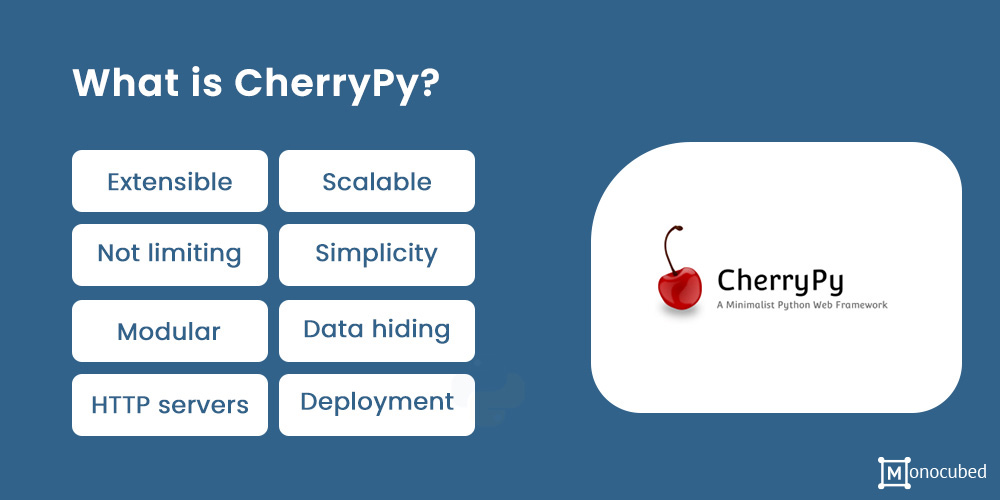
CherryPy is a Python-based web application framework used for rapid development. The official site calls it “a minimalistic, Pythonic, object-oriented web framework” that is used for wrapping over the HTML protocol. You can build web apps in less time with smaller and cleaner codes.
Developed 10 years ago by Remi Delon, the framework is one of the oldest Python frameworks that remains relevant and keeps updating itself to match with the growing community. Some features provided by CherryPy that makes it widely beloved are-
- Extensible – This allows you to use all the Python tools and libraries without any hassle.
- Scalable – You can quickly scale your CherryPy applications to handle more users.
- Not limiting – You can use your choice of technology for templating, databases, architecture.
- Simplicity – It has simple syntax and coding rules. If you know Python, you will be able to write a program in a matter of minutes.
- Modular– The framework is modular, providing independent, reusable components that increase the efficiency and speed of development.
- Data hiding – All the modules are independent and employ data abstraction to reduce complexity.
- HTTP servers – It has its own HTTP server where your application can be hosted.
- Deployment – The web app can be deployed on any WSGI-compliant gateways without added costs.
What is Flask?
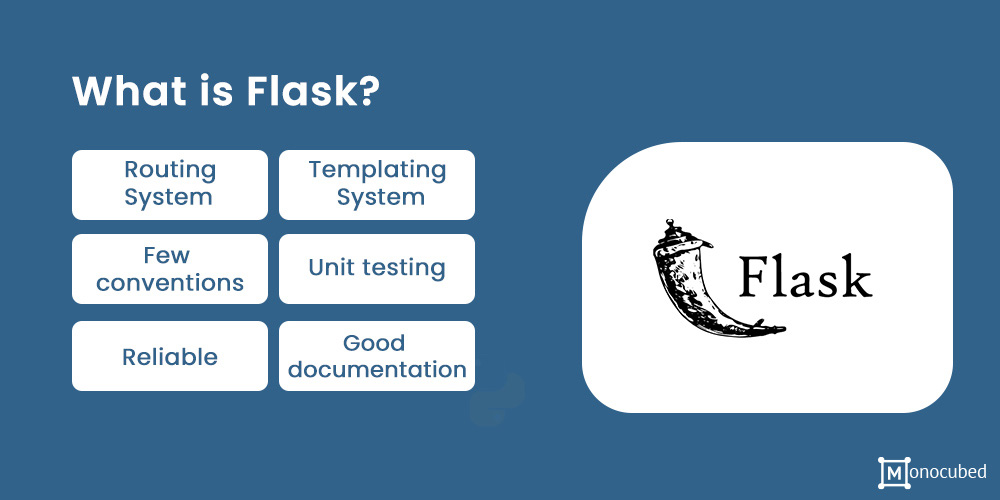
Flask is a micro Python web framework that aims to keep the core simple and easily extensible.
You can use this web app framework to compile modules and libraries and write a high-functioning web app. Flask is pythonic in nature, using explicit methods to remain as close to the working of the programming language compared to other web frameworks.
Flask is the perfect combination of flexibility and structure. It gives you tools and utilities that assist you in speedy development but gives you the flexibility to choose your database and template engines and servers.
Features that make Flask one of the top micro-frameworks are –
- Routing System is based on the WSGI application utility library, Werkzeug, which acts as a routing system.
- Templating System – Jinja2 works as its template engine.
- No requirement for writing low-level code like thread management and protocols.
- A few conventions for templating and storing data although they can be easily changed.
- Support for inbuilt unit testing.
- Synchronous request processing supported.
- Reliable – Many popular companies such as Netflix use the framework for their websites.
- Good documentation.
Have a Web App Idea in Mind?
We are interested. Be it a simple web app for your startup or a complex enterprise solution, we can help develop it.
Flask VS CherryPy – Differences Between The Python Frameworks
Popularity
Flask is a very popular web framework for Python developers. It has around 54.5K stars on GitHub with 635 active contributors. It also has a more active job market, with Flask being a requirement for some Python developers.
In comparison, although CherryPy is much older, it has relatively less popular among developers. It has just 1.4K stars on GitHub with 109 contributors. In terms of popularity, there is a clear winner, Flask.
Databases support
Neither of the frameworks has an inbuilt ORM system. Flask has access to a lot of libraries that will support development with NoSQL databases and mappers. You can use Flask-PyMongo if you want to integrate MongoDB.
Similarly, CherryPy can use Python libraries and extensions for managing relational databases. You can also use modules and libraries to work with CouchDB, Cassandra, and DynamoDB.
Security features
The CherryPy framework has inbuilt functionalities for code encoding, user authorization, sessions, and caching. Its core also has a full test suite for testing and debugging your application.
Flask includes stringent practices for protection against Cross-Site Scripting (XSS) and JSON security. But it does not interfere with Cross-Site Request Forgery (CSRF) and you will have to set up the response header, Content Security Policy (CSP).
Templating Engines
Templates are files that hold static data and can also be used as placeholders for dynamic data. With the support of the templating engine Jinga, Flask is capable of rendering templates to get the final document. HTML supports WSGI web applications (The Web Server Gateway Interface(WSGI) applications can receive forwarded requests from web servers.)
CherryPy does not provide any HTML templating system. But you can easily integrate popular ones such as Mako or Jinja2 or Cheetah into the architecture. It also has WSGI support; thus you can convert your web app into a WSGI app.External libraries
One advantage of Flask is that it has a much more developed community than CherryPy. Its popularity ensures that there are more solutions available if you run into an issue. In addition, it also has a lot of external libraries and utilities that can be quickly integrated to implement common tasks.
CherryPy is extremely flexible and extensible. Integration of any standard Python library is easy and straightforward. But, due to a lack of a large community, there are no targeted solutions and tools available. This is a major issue because it is a microframework and is minimalistic and lightweight, having very few core features.
CherryPy OR Flask: What to Choose?
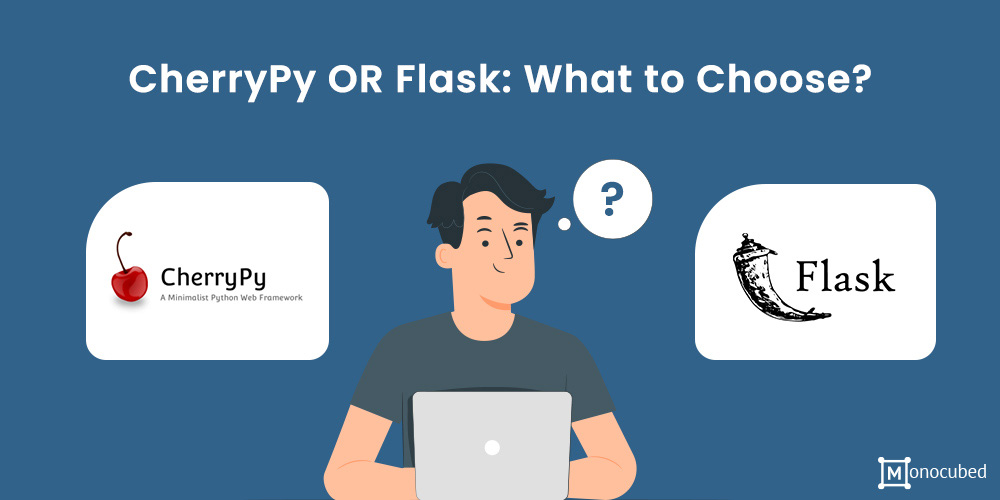
Do all developers face this question of – Flask or CherryPy? Both the Python web frameworks are quite close to each other. The main difference between cherrypy and flask is the popularity. Flask enjoys massive support from a huge community of developers. Due to its popularity, Flask invariably is much more mature even though it has fewer years in its name.
When to Use Flask?
The popularity of Flask is due to the ease with which it can be used, engaging vanilla HTML and Python. With very few lines of source code, you can have a working application.
- Good for Startups – Flask’s modularity and scalability ensure that startups can start small and expand their website as their company grows.
- It is much easier to build web APIs with Flask than CherryPy,
- Better for large-scale web applications
When to Use CherryPy?
CherryPy is an underrated gem of Python web tools. Each Cherry application can work as a stand-alone Python web application as it has its own multi-threaded HTTP development server. We recommend CherryPy for –
- It is a great framework that is perfect for developing REST APIs with inbuilt tools.
- Suitable for small-scale applications that require rapid development
- When you have experienced developers, as CherryPy lacks cohesive documentation
Frequently Asked Questions
Is CherryPy dead?
No, it is far from being dead. It is a mature framework that is designed for specific use cases. Thus, it may not have as much popularity as other Python web frameworks but it is still widely used for application development.
Is Flask a frontend or backend framework?
Flask is a backend framework. It is a minimalistic microframework and does not include a database abstraction layer or form validations. It lets the developers decide their choice of tools and libraries. JavaScript frameworks like Angular will help you develop the best frontend for Flask applications.
Is Flask better than Django?
Flask and Django serve different purposes. Flask is easier to use and is suited for projects on a smaller scale. If you require something more robust with out-of-the-box features and large-scale implementations, Django is a better choice for you. For more details, you can read our blog on Flask vs Django
Conclusion
CherryPy and Flask are two extremely useful frameworks for Python development projects. With this blog, we have brought to you a comparison of Flask vs CherryPy, analyzing the difference and functionalities of both.
Contact Monocubed for receiving guided assistance through the development process. Our team can help you find the right fit for your company. For more such blogs, you can subscribe to our newsletter.
 By Jeel Patel
By Jeel Patel
